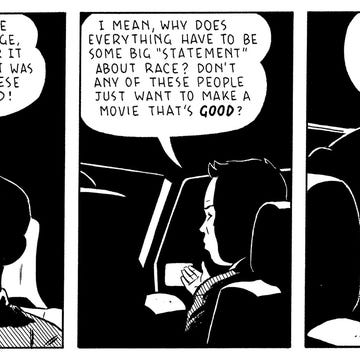In museums that display modern and contemporary paintings, visitors get the opportunity to use their own imagination and perceptions to interpret or construct a work’s meaning. Eavesdrop among the patrons and you might hear some of these interpretations: viewers don’t simply serve as passive consumers of paintings but actively make meanings. It’s not unlike the Rorschach test, an assessment tool popular with 1960s psychologists, who asked patients what they saw in inkblots to gain insight into how their minds worked.
In a recent op-ed in the New York Times, Danzy Senna, the author of September’s California Book Club selection, Colored Television, commented that multiracial people in the United States “are and always have been a Rorschach test for how the world is processing its anxiety, rage, confusion and desire about this amorphous construction we call race.” While a Rorschach test depends on the inkblots’ having no figurative elements, the better to elicit the viewer’s own state of mind, an exciting aspect of Colored Television is the vivid complexity of its characters—its figures.
You might think a novel’s specificity, in contrast to an inkblot, would lead to more consensus around its meaning, but the dazzling precision of Colored Television, its lifelike portraits, only make it more challenging to wrap one’s mind around any single, final interpretation of its text. Most readers can absorb and impute meaning to only so many of the particulars Senna offers; as with the Rorschach, what a reader perceives in and pulls from the book to construct a meaning reveals the reader as much as the text.
Colored Television concerns race, among other things—but it’s not possible to infer from these pages (or those of any of Senna’s other novels, Caucasia, Symptomatic, or New People) any sort of dictum about what Senna calls an “amorphous construction.” Rather, we’re presented with images, feelings, atmospheres—all contingent on what they’re juxtaposed with, things that could easily morph when read with different historical or personal contexts in mind. Senna isn’t going for single political positions or moral judgments—her novels feature tones and moods, not social messages. During an interview with me, Senna explained, “I sometimes think of my books when I’m writing them as a painting. Like, I can’t really say what I’m trying to do, but I could visualize a painting and a kind of abstract painting, because that’s the most emotionally powerful but completely inarticulate way of thinking about the emotion you’re going for. And I know that New People has a certain vibe that I think is closer to Symptomatic. And then Colored Television feels like a different energy to me and like a different color almost to me.”
In this novel, the protagonist, Jane, and her husband, Lenny, are a novelist and a painter, respectively. They house-sit for wealthier people, including, in the time frame of the novel, Brett, Jane’s biracial friend from her MFA program, a successful screenwriter and director. In one scene, Jane realizes that she’s being perceived differently by the other public school mothers because she is throwing her child’s birthday party in Brett’s house: “What had appeared to them as a regular public school family had transformed into something glittery, deracinated. This house made them seem like lucky, special Negroes.” Change what surrounds a family and the resulting image might conjure a different interpretation of who they are.
Of her art, Jane observes, “You had to have an almost religious faith in process if you were to write fiction. It was so much like dreaming. The subconscious held the answers.” Likewise, as a painter of abstracts, Lenny’s artistic process also engages the subconscious. Intriguingly, the top layer of some of his paintings features masks of color that occlude the figures painted beneath them. The narrator tells us, “It was one of his signature paintings on top of a painting. In this one, he’d first created some elaborate and intricate scene—a family seated at a table—then painted over them so you couldn’t make out their expressions, only that they were four figures hidden beneath a layer of swirling gray paint.”
Similarly, Jane protects herself by obscuring intricate, slant truths and stories with other more self-serving claims—we know this because Senna skillfully allows us to partially glimpse those other accounts. Jane may disdain Brett’s genre movies, for instance, but one night prior to the action of the novel, he professes love for her, and we can observe that some of her story about who Brett is—not qualified to poach what she views as her material—involves self-deception, an assuaging of her own wounds. Brett’s story about their friendship is plainly something else. Later, Jane has a sex dream about him that seems to mirror a TV show concept she presents to producer Hampton Ford, one in which two biracial people marry and their mixedness is not tragic. She tells Hampton, “In the show I want to make, see, I want to show mulattos in a different light. Show us being, you know, just regular. Relatable.”
By depicting “regular” people, Colored Television achieves what Jane hopes for with her work—unusual and original art; a human comedy produced in an unprecedented era of American multiraciality. While Jane’s fantasy life overflows with aspirational imagery, the novel refuses the pleasant façades of Benetton and Hanna Andersson ads. Full of envy, resentment, hypocrisy, greed, hope, and tenderness, Senna’s flawed contemporary characters perceive and talk and behave in real ways that we don’t often see in novels. Senna remarked to me, “I think that is the impulse to create art, in some ways, to draw a replica of something you’re seeing that isn’t seen. The caveman drawing the picture on the wall. We’re still doing that in some way.”•
Join us on September 19 at 5 p.m. Pacific time, when Senna will sit down with CBC host John Freeman and special guest Porochista Khakpour to discuss Colored Television. Register for the Zoom conversation here.
ART AND FAMILY
Check out Nichole LeFebvre’s comic about Colored Television. —Alta
ZEITGEIST
Read critic J. Howard Rosier’s essay on the difficulty of placing Senna’s work within today’s conversations about race. —Alta
TECHNOLOGY AND TECHNE
CBC editor Anita Felicelli reviews Rachel Kushner’s “singular and enthralling” novel of spies, climate activism, and modernity, Creation Lake. —Alta
FASTEST-GROWING DEMOGRAPHIC
Read Senna’s stirring piece criticizing Donald Trump’s remarks about Kamala Harris. —New York Times
LITERARY BACKLASH
In a controversial move, wealthy Stanford University has decided to phase out its nearly two dozen Jones lecturers, potentially harming the creative writing program. A petition is circulating to ask the school to reverse course. —KQED
DIGITAL COPIES
In a significant decision, the U.S. Court of Appeals for the Second Circuit upheld a lower court’s ruling that San Francisco–based Internet Archive violated copyright law when it scanned and shared digital books without the permission of their publishers. —KQED
Alta’s California Book Club email newsletter is published weekly. Sign up for free and you also will receive four custom-designed bookplates.



















